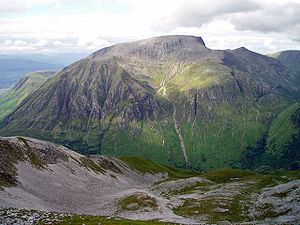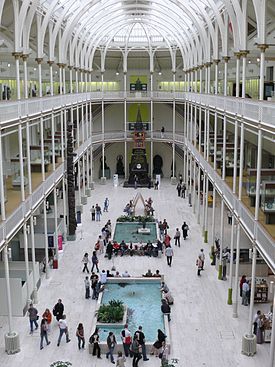Portal:Scotland
| Main Page | Selected articles 1 | Selected articles 2 | Selected biographies | Selected quotes | Selected pictures | Featured Content | Categories & Topics |
Introduction
 |

|
|

| ||
Scotland (Scots: Scotland; Scottish Gaelic: Alba) is a country that is part of the United Kingdom. It contains nearly one-third of the United Kingdom's land area, consisting of the northern part of the island of Great Britain and more than 790 adjacent islands, principally in the archipelagos of the Hebrides and the Northern Isles. To the south-east, Scotland has its only land border, which is 96 miles (154 km) long and shared with England; the country is surrounded by the Atlantic Ocean to the north and west, the North Sea to the north-east and east, and the Irish Sea to the south. The population in 2022 was 5,436,600 and accounts for 8% of the population of the UK. Edinburgh is the capital and Glasgow is the largest of the cities of Scotland.
The Kingdom of Scotland emerged in the 9th century. In 1603, James VI inherited England and Ireland, forming a personal union of the three kingdoms. On 1 May 1707 Scotland and England combined to create the new Kingdom of Great Britain, with the Parliament of Scotland subsumed into the Parliament of Great Britain. In 1999 a Scottish Parliament was re-established, and has devolved authority over many areas of domestic policy. The country has a distinct legal system, educational system, and religious history from the rest of the UK, which have all contributed to the continuation of Scottish culture and national identity. Scottish English and Scots are the most widely spoken languages in the country, existing on a dialect continuum with each other. Scottish Gaelic speakers can be found all over Scotland, however the language is largely spoken natively by communities within the Hebrides. The number of Gaelic speakers numbers less than 2% of the total population, though state-sponsored revitalisation attempts have led to a growing community of second language speakers.
The mainland of Scotland is broadly divided into three regions: the Highlands, a mountainous region in the north and north-west; the Lowlands, a flatter plain across the centre of the country; and the Southern Uplands, a hilly region along the southern border. The Highlands are the most mountainous region of the British Isles and contain its highest peak, Ben Nevis, at 4,413 feet (1,345 m). The region also contains many lakes, called lochs; the term is also applied to the many saltwater inlets along the country's deeply indented western coastline. The geography of the many islands is varied. Some, such as Mull and Skye, are noted for their mountainous terrain, while the likes of Tiree and Coll are much flatter. (Full article...)
Selected article

Ben Nevis (/ˈnɛvɪs/ NEV-iss; Scottish Gaelic: Beinn Nibheis, Scottish Gaelic pronunciation: [pe(ɲ) ˈɲivɪʃ]) is the highest mountain in Scotland, the United Kingdom, and the British Isles. The summit is 1,345 metres (4,413 ft) above sea level and is the highest land in any direction for 739 kilometres (459 miles). Ben Nevis stands at the western end of the Grampian Mountains in the Highland region of Lochaber, close to the town of Fort William.
The mountain is a popular destination, attracting an estimated 130,000 ascents a year, around three-quarters of which use the Mountain Track from Glen Nevis. The 700-metre (2,300 ft) cliffs of the north face are among the highest in Scotland, providing classic scrambles and rock climbs of all difficulties for climbers and mountaineers. They are also the principal locations in Scotland for ice climbing.
The summit, which is the collapsed dome of an ancient volcano, features the ruins of an observatory which was continuously staffed between 1883 and 1904. The meteorological data collected during this period is still important for understanding Scottish mountain weather. C. T. R. Wilson was inspired to invent the cloud chamber after a period spent working at the observatory.
Selected quotes
" ... Maxims are the condensed good sense of nations ... "
" ... Who thinks the law has anything to do with justice? It’s what we have because we can’t have justice ... "
In the news
Selected biography

Sir Christopher Andrew Hoy MBE (born 23 March 1976) is a former track cyclist and racing driver from Scotland who represented Great Britain at the Olympic and World Championships and Scotland at the Commonwealth Games.
Hoy is an 11-time world champion and a six-time Olympic champion. With a total of seven Olympic medals, six gold and one silver, Hoy is the second most decorated Olympic cyclist of all time. Between 2012 and 2021, he was the most successful British Olympian and the most successful Olympic cyclist of all time. In 2021, he finally ceded both records to erstwhile colleague and rival Sir Jason Kenny. His 17 global titles across four disciplines make Hoy the most successful track cyclist at the global level of all times.
With his three gold medals in 2008 Summer Olympics, Hoy became Scotland's most successful Olympian, the first British athlete to win three gold medals in a single Olympic Games since Henry Taylor in 1908, and the most successful Olympic cyclist of all time. After winning a further two gold medals (in the keirin and team sprint) at the 2012 Summer Olympics, Hoy has won the second-most Olympic gold medals (six) of all British athletes, behind Jason Kenny, and more total medals (seven) than any except fellow cyclists Kenny and Sir Bradley Wiggins. Hoy has won Olympic gold medals in more separate events — team sprint (twice), match sprint, keirin (twice) and kilo — than any other cyclist.
Selected picture
The National Museum of Scotland is one of Scotland's national museums, on Chambers Street, in Edinburgh. The original Royal Museum began in the 19th century and was added to in the 1990s when a new building known as The Museum of Scotland was added, both merging in 2007 into The National Museum of Scotland.
Photo credit: Shimgray
Did You Know...

- ... that visitors to Balmaclellan in Scotland can stay in a historic watermill that is "remarkable" for the preservation of its internal workings?
- ... that William of Littlington opposed the division of England and Scotland into two Carmelite provinces in 1303, was excommunicated, and did four years' penance in Paris?
- ... that of the 16 teams to enter the inaugural Scottish Cup, only Dumbarton, Kilmarnock and Queen's Park still regularly compete in the competition?
- ... that Scottish novelist Isla Dewar said "if ... a thing is not worth doing then it's worth doing fabulously, amazingly, with grace, style and panache"?
- ... that Scottish scientists attempted to create a carrot-based substitute for carbon fibre?
- ... that Scottish nurse Euphemia Steele Innes was decorated with the Royal Red Cross first class for services with the Territorial Force Nursing Service in World War I?
- ... that background research for Dujanah included interviews with Muslim apostates and a Scottish veteran of Afghanistan?
- ... that after the Battle of Winwick in 1648 some Scottish prisoners were sold as slaves?
Get involved
For editor resources and to collaborate with other editors on improving Wikipedia's Scotland-related articles, see WikiProject Scotland.
To get involved in helping to improve Wikipedia's Scotland related content, please consider doing some of the following tasks or joining one or more of the associated Wikiprojects:
- Visit the Scottish Wikipedians' notice board and help to write new Scotland-related articles, and expand and improve existing ones.
- Visit Wikipedia:WikiProject Scotland/Assessment, and help out by assessing unrated Scottish articles.
- Add the Project Banner to Scottish articles around Wikipedia.
- Participate in WikiProject Scotland's Peer Review, including responding to PR requests and nominating Scottish articles.
- Help nominate and select new content for the Scotland portal.
Do you have a question about The Scotland Portal that you can't find the answer to?
Post a question on the Talk Page or consider asking it at the Wikipedia reference desk.
Related portals
Other language versions
Associated Wikimedia
The following Wikimedia Foundation sister projects provide more on this subject:
-
Commons
Free media repository -
Wikibooks
Free textbooks and manuals -
Wikidata
Free knowledge base -
Wikinews
Free-content news -
Wikiquote
Collection of quotations -
Wikisource
Free-content library -
Wikispecies
Directory of species -
Wikiversity
Free learning tools -
Wikivoyage
Free travel guide -
Wiktionary
Dictionary and thesaurus








































